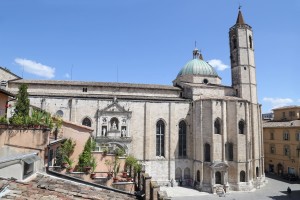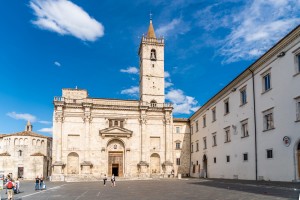There’s a hidden yet monumental treasure surrounded by three mountains and the confluence of two rivers waiting to be discovered at the heart of the breathtakingly stunning nature of the southern Marche. Ascoli Piceno, capital of the eponymous province, is home to a rather compact 47,000 inhabitants. Still, it is one of Italy’s best-known cities of arts. That’s mostly due to the impressive architecture, the medieval charm and the striking travertine aesthetic giving the historic centre its distinctive look with its warm colours. You’d like to know exactly what there is to expect? Well, let’s get things started!
Italics or woodpeckers?
We won’t say too much about Ascoli Piceno’s history for a change, simply because there isn’t a whole lot out there. It was likely the capital of the Piceni, an Italic population during the Iron Age. The city’s name came either from them or from a woodpecker ritual performed by the Sabines (“woodpecker” approximately translates to “picchio” in Italian). The region was later conquered by the Romans and eventually hotly contested by the Ostrogoths, the Lombards and the Franks. Galeotto I Malatesta and Francesco I Sforza used the unstable Middle Ages to establish brutal dictatorships. Eventually, Ascoli Piceno fell under Papal control in 1482 where it remained until the Kingdom of Italy was founded.
Piazza del Popolo and Piazza Arringo

©Bigstock.com/trotalo
While there isn’t much to tell on a historical level, Ascoli Piceno actually has a lot to offer as a city of arts. This is in part due to the abundantly used travertine, a bright limestone from sweet water springs that dominates the historic centre. The two main squares Piazza del Popolo and Piazza Arringo are home to the city life. And there’s a lot to see for you:
- Dom Sant’Emidio: Even though hardly anything of the original Romanesque building survived – we highly recommend checking out the crypt – Ascoli Piceno’s cathedral remains the city’s most important church. Extensive travertine works join the baroque conversions to form a harmonious overall look. Don’t miss out on the polyptych altarpiece on the right side of the altar.
- San Francesco: This enormous Gothic hall church was built between 1258 and 1371. San Francesco is flanked by an enormous market hall and a Renaissance cloister housing a morning market. Explore the large lateral entrance to Piazza del Popolo to discover a monument for Pope Julius II.
- Palazzo dell’Arengo: Piazza Arringo is also known as Piazza dell’Arengo and this palace is one of its most important buildings. Formed by the fusion of two older palaces, the travertine façade with its five porticos certainly knows to impress. Find the art gallery Pinacoteca Civica behind them.
- Baptistery: The cathedral was dedicated to Saint Emygdius, the city’s patron saint, but the baptistery is all about Saint John. This ideal of Ascoli’s Romanesque architecture is a national monument of Italy. The travertine façade might look plain at first, but take a closer peek to discover several fascinating details.
- Diocesan museum: Part of Piazza Arringo’s palace complex, this huge museum preserves the diocese’s art treasures. Among the focal points are a collection of Florentine 16th century art and an entire area dedicated to the city’s various art schools and movements from the 13th century to today.
Other sights in Ascoli Piceno
By the way, there’s much more to Ascoli Piceno beyond the travertine masterpieces known far beyond the Marche. Here are some lovely sights that are certainly worth a second or even a third look:
- Ponte di Cecco: Experience Ascoli Piceno’s Roman heritage outside the city. The arch bridge Ponte di Cecco was built in 25 BC during Emperor Augustus’ reign and formed part of a supply road between Rome and the coast of the Adriatic Sea. According to lore, the devil built this bridge in just one single night.
- Ponte Romano di Solestà: A second arch bridge, dating back to Augustus’ reign as well, spans the river Tronto and connects to the San Giacomo district. Sadly, the old city wall is mostly gone.
- San Pietro Martire: The church of the Dominican Order gets lost in the shuffle being located on a small square at an intersection. San Pietro Martire’s façade exhibits a rather low-key look, but don’t miss out on the gloriously bright apse. The marble statues at the main altar and the frescoes on the side walls are genuine eye-catchers.
- San Vittore: Romanesque meets Gothic architecture for a neat little church made of travertine marble blocks. The window rose is clearly Gothic, the belfry has a curiously square shape and likely used to house the baptistery until a lightning strike decimated the old tower. Various anonymous frescoes, some of which have since been transferred to the diocesan museum, line San Vittore’s walls.
The Quintana

©Bigstock.com/DinoPh
Finally, we have a neat event for you. The first Sunday in August is Ascoli Piceno’s main festivity. A large parade with about 1,500 participants in Renaissance costumes honours patron saint Emygdius. The equestrian tournament Quintana takes place afterward. It sees six knights, each representing one of the city’s six neighbourhoods, compete on a course. Holding lance and shield, they try to hit the effigy of a Saracen warrior. The big city feast in the evening packs all tables to maximum capacity. You absolutely have to try the local speciality Olive all’Ascolana, giant fried olives stuffed with meat.
Ascoli Piceno is small but nice without a doubt. Being a city of arts, it carries a unique travertine flair giving the historic centre a noble, historic charm. Look forward to a hidden treasure full of Roman heritage, enormous Romanesque and Gothic churches, and a truly amazing festivity in the south of the Marche, surrounded by equally glorious nature and countless hiking trails. Ascoli Piceno is definitely worth a trip!